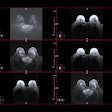
The recent approval of a Current Procedural Terminology (CPT) code for radiology artificial intelligence (AI) by the American Medical Association (AMA) was an important milestone. But actual reimbursement will likely take some time.
Officially added on July 1 and set to take effect on January 1, 2022, the new category III code -- 0691T -- would apply to the use of AI for automated analysis of existing CT studies for vertebral fracture(s), including assessment of bone density when performed, data preparation, interpretation, and reporting.
 Dr. Melissa Chen.
Dr. Melissa Chen.The code was approved by the AMA after representatives from the RSNA, American College of Radiology (ACR), the American Roentgen Ray Society (ARRS), and the Association of University Radiologists initially proposed the code in a presentation at the AMA CPT Editorial Panel meeting in February.
This use of AI will advance radiology's role in population health by utilizing existing imaging to assess patients at risk for more debilitating osteoporotic fractures such as hip fractures, said Dr. Melissa Chen of the University of Texas MD Anderson Cancer Center in Houston.
"These patients can be appropriately medically managed to improve morbidity of this at-risk population," Chen said.
The use of AI to assess prior CT studies for incidental findings of vertebral fractures could provide significant clinical value.
"Vertebral fractures are notoriously frequently not mentioned by radiologists on thoracic or abdominal CT scans unless there is moderate-to-severe loss of height of the vertebral body," said Dr. Eliot Siegel of the University of Maryland and the Baltimore VA Medical Center.
 Dr. Eliot Siegel.
Dr. Eliot Siegel.Importantly, the combination of a vertebral fracture and low bone mineral density is synergistically associated with a high likelihood of additional -- and potential debilitating -- vertebral body fractures, Siegel said. Although dual-energy x-ray absorptiometry (DEXA) is currently the gold standard for determining bone mineral density, CT can also be used.
Siegel noted that another category III CPT code -- 554T -- includes the determination of bone strength and fracture risk using finite element analysis, a computer simulation technique that utilizes functional data and analysis of bone mineral density from a CT scan.
"[554T and 0691T] represent two related, but separate algorithms," Siegel said.
An important first step
The new CPT code for automated assessment of vertebral fracture is an important first step in facilitating the adoption of AI technology, Chen said.
"More importantly, radiological specialty societies led the code proposal, ensuring that radiologists -- the physician experts in imaging appropriateness, acquisition and interpretation -- remain a part of the payment models for AI," said Chen, who also serves as advisor for the American Society of Neuroradiology to the AMA Relative Value Scale Update Committee and as chair of the economics committee for the American College of Radiology (ACR) Commission on Patient- and Family-Centered Care.
Israeli AI software developer Zebra Medical Vision, which garnered FDA 510(k) clearance in May 2020 for its software for analyzing vertebral compression fractures, also hailed the new code.
"The recognition of AI as an integral part of the radiologist workflow by the AMA is pivotal for expanded adoption and acceptance, perception, and robust reimbursement strategies," said Dr. Orit Wimpfheimer, chief medical officer and head of product strategy at Zebra.
Zebra now expects greater awareness of AI's merit in population health screening in general, as well as increased utilization of its software for detecting vertebral compression fractures to treat the most high-risk osteoporotic patients and prevent hip fractures, Wimpfheimer said.
The CPT code is structured so that ordering clinicians need to request AI screening for vertebral body compression fractures when ordering exams, Wimpfheimer said.
"We consider this as the first milestone in achieving population health screening on a national and then global scale," Wimpfheimer told AuntMinnie.com. "The ultimate goal is to automatically screen the age-appropriate population to make the biggest impact in preventative healthcare by treating medical conditions at an earlier phase of the disease to decrease the morbidity, mortality, and financial cost associated with the later-stage, more debilitating chronic conditions."
Patience needed
Although the new CPT code sets an important precedent for radiology AI, there are some caveats, Siegel said. Category III CPT codes are temporary codes designed for emerging technologies, services, and procedures. These codes then result in collection of data to create documentation for U.S. Food and Drug Administration (FDA) product clearance and to validate the general clinical application, Siegel said.
"These do not mean to imply [Medicare] or private payor reimbursement," Siegel said.
The 0544T and 0691T CPT III codes represent promising very early steps toward more routine reimbursement of AI algorithms by the U.S. Centers for Medicare and Medicaid Services (CMS) and other payors, Siegel said. However, he anticipates that this "will be a very slow process requiring a good deal of collection of compelling data and patience by the diagnostic imaging community."
It's unlikely that any payors will reimburse for 0691T in the near term, said Sandy Coffta, vice president of client services at billing services provider Healthcare Administrative Partners (HAP).
 Sandy Coffta.
Sandy Coffta."CPT III codes are typically considered experimental or investigational and denied by the majority of insurances," she said. "In the midterm – two to three years -- we may see some payers reimburse this code but consistent reimbursement is unlikely until a permanent (category I) CPT code is assigned."
Despite the lack of immediate reimbursement, it's still important to submit claims for CPT III codes; utilization data from a CPT III code is used to support creation of an eventual category I CPT code, according to Coffta.
The typical expectation for a standard CPT III code is that it will lead to a permanent -- category I -- code within five years, Coffta said.
"Whether that happens or not for 0691T will depend on a number of factors," she told AuntMinnie.com. "In addition to utilization data, the CPT Editorial Panel will consider published research on the clinical efficacy of the service when deciding whether a category I code should be created."
It will likely take years before reimbursement begins, Siegel said.
"I believe [CMS] and payors will be slow to pay for this despite the CPT code, but this will encourage data collection on this important clinical issue and will allow radiology as a specialty to collect data to make a strong economic case for reimbursement," Siegel said.
As it's a category III CPT code, payment decisions will be made at a local level at the discretion of the payor, Chen said.
"I would anticipate that this may take some time as payors determine if they [will] reimburse and the amount of reimbursement for this service," Chen said. "The payment rate may be highly variable."
Wimpfheimer of Zebra said, however, that the new CPT code has already drawn the attention of payors.
"We believe that this CPT code testifies to the value that screening for vertebral body compression fractures can provide and we are already seeing interest among payers to institute programs to implement this screening among their providers," Wimpfheimer said.
Impact on radiology AI
This radiology AI-specific application could be a harbinger of what's to come.
"I believe that this type of 'population' health application will lead to requests for many additional CPT codes such as coronary artery calcification on conventional thoracic CT, abdominal aneurysm detection on thoracic, abdominal and pelvic CT scans, evaluation of cardiac chamber enlargement, [chronic obstructive pulmonary disease (COPD)], renal calculi, and many others," Siegel said.
The new CPT code opens the door for reimbursement of the use of AI in radiology, supporting the economics and incentives for adoption of the technology at scale, according to Wimpfheimer.
"We believe that other applications will follow, substantiating the broader use of AI and augment the work done by radiologists in areas of triage, productivity, and population health," Wimpfheimer said.
 Michael J. Cannavo.
Michael J. Cannavo.Even though payment for a CPT III code is at the discretion of each payer, the AMA's issuance of a CPT code for radiology AI is the first step toward being able to show a return on investment for the technology, according to imaging consultant Michael J. Cannavo.
"A business case for reimbursement that insurance providers will accept needs to be developed," Cannavo said. "That is fairly easy to do, though, if you understand the provider's requirements."
The AMA's decision hopefully will also enable payors, AI developers, and radiologists to see a reimbursement path forward in adoption of AI technology, and in particular, how AI can augment radiologists' role in improving population health, Chen said.



















